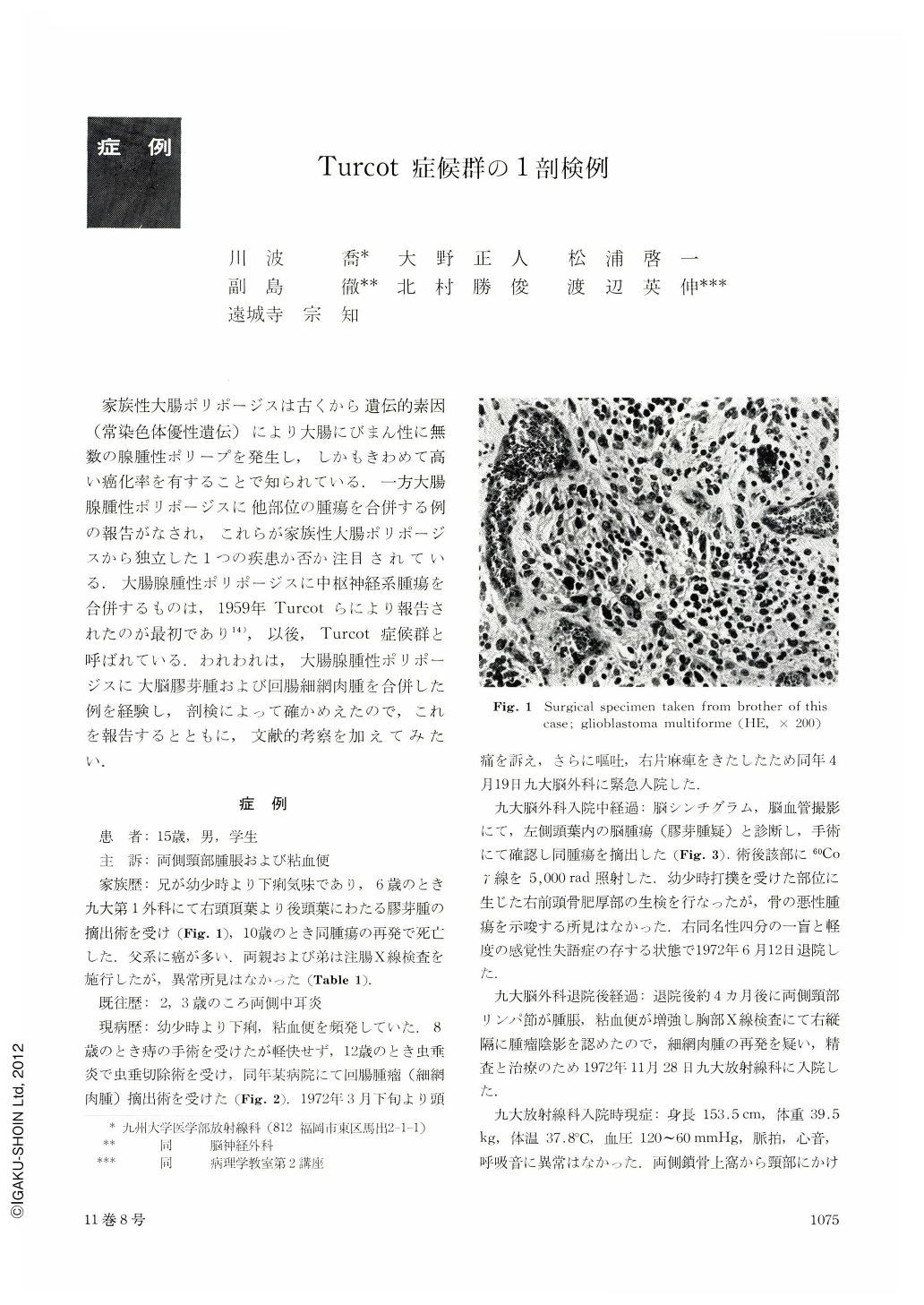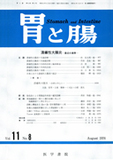Japanese
English
- 有料閲覧
- Abstract 文献概要
- 1ページ目 Look Inside
家族性大腸ポリポージスは古くから遺伝的素因(常染色体優性遺伝)により大腸にびまん性に無数の腺腫性ポリープを発生し,しかもきわめて高い癌化率を有することで知られている.一方大腸腺腫性ポリポージスに他部位の腫瘍を合併する例の報告がなされ,これらが家族性大腸ポリポージスから独立した1つの疾患か否か注目されている.大腸腺腫性ポリポージスに中枢神経系腫瘍を合併するものは,1959年Turcotらにより報告されたのが最初であり14),以後,Turcot症候群と呼ばれている.われわれは,大腸腺腫性ポリポージスに大脳膠芽腫および回腸細網肉腫を合併した例を経験し,剖検によって確かめえたので,これを報告するとともに,文献的考察を加えてみたい.
This is a report of an autopsy case of Turcot's syndrome. A 15-year-old male was admitted to the Department of Radiology, Kyushu University Hospital with a history of repeated episodes of diarrhea and bloody stools since early infancy, and recent cervical swelling. At 8 years of age, he underwent a hemorrhoidectomy ; at 12, an appendectomy and an ileal resection for reticulum cell sarcoma. On April 19, 1972, a right temporal lobe glioblastoma multiforme was removed in the Department of Neurosurgery of Kyushu University. For two months prior to admission, he developed bilateral cervical lymphadenopathy and exacerbations of grossly bloody stools.
The patient's elder brother also had diarrhea from infancy, and died of a glioblastoma multiforme at the age of 10 years. Barium enema examinations disclosed that the parents and a younger brother 9 years of age were free from colonic polyposis.
On physical examination the patient had multiple cafe-au-lait spots. Complete gastrointestinal series and endoscopy revealed multiple polyps of the entire gastrointestinal tract. After an uneventful course the patient died on May 5, 1973.
Autopsy revealed multiple adenomatous polyps of the entire gastrointestinal tract. Three were in the stomach; two, in the duodenum; two, in the jejunum; and eighty-five were in the colon. Six of the colonic polyps were malignant. Two additional lesions proved to be advanced cancers; one, in the cecum; the other, in the descending colon. No residua of reticulum cell sarcoma or glioblastoma multiforme were seen.
In 1959, Turcot, Despres and St. Pierre described a brother and sister with adenomatous polyposis of the colon associated with tumors of the central nervous system. This condition has since been termed Turcot's syndrome. It has not yet been determined, however, whether this syndrome differs from familial polyposis of the colon. McKusick reported that Turcot's syndrome is possibly inherited as an autosomal recessive. Smith suggested that the association of adenomatous polyposis of the colon with brain tumors might be due to a phenotypic neoplastic expression of at least one of several mutant genes, individually capable of producing familial polyposis of the colon.
The authors reviewed seventeen reported cases of Turcot's syndrome. Nearly all had large scattered polyps throughout the colon, their distribution and size having been somewhat different from the usual familial polyposis of the colon. In each case reported by Turcot, and Baughman, and in the case reported here, a brain tumor and multiple polyps of the colon were found in children of clinically unaffected parents. A recessive mode of transmission therefore cannot be excluded.

Copyright © 1976, Igaku-Shoin Ltd. All rights reserved.


